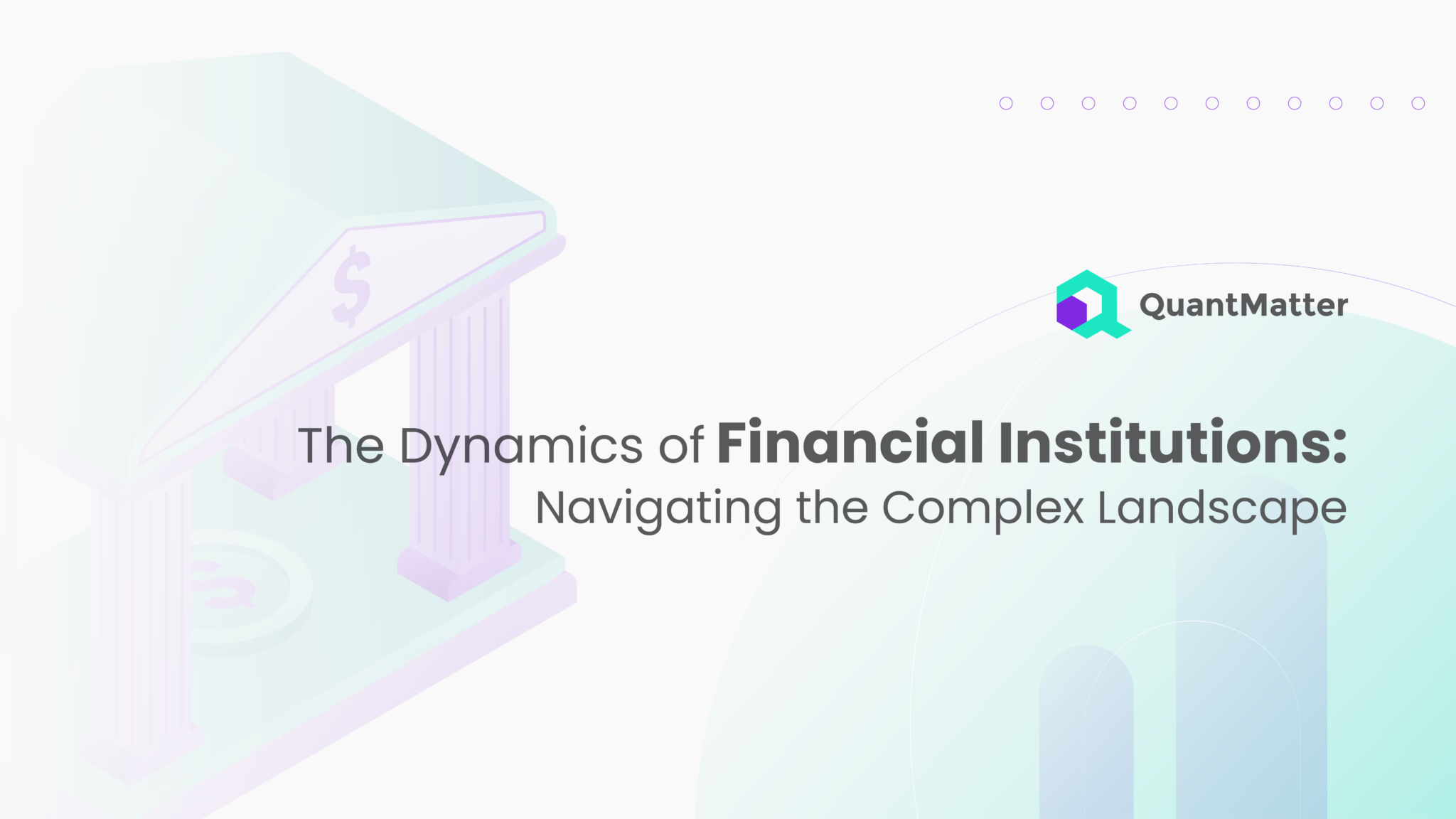
Financial institutions are at the center of the global economy, as they are the heart of financial systems worldwide. Financial institutions operate in an ever-changing mosaic of compliance standards, technological innovations, and economic factors. This delicate balancing act requires an unparalleled amount of adaptability from these institutions, not only to keep up with clients’ varying demands but also to flourish in a world that is constantly changing.
The regulatory environment is also constantly changing. As new standards and guidelines are imposed by governments and international organizations to ensure stability and integrity, financial institutions need to remain alert, interpret and properly implement these changing rules. From traditional banks to modern fintech companies, these types of firms channel money, provide a variety of services, and make an essential contribution to economic stability. In this paper, we examine the complicated relationship between functions, difficulties, and changes in the financial world.
Functions of Financial Institutions

Financial institutions perform important functions in the economy. Here are the key functions they perform:
Intermediation
The mechanism of financial intermediation plays an important role in the economic framework because it connects entities with surpluses with those in need of finances. People and companies with surplus funds put these funds in financial institutions, especially banks.
These institutions, in turn, use these deposits to lend to borrowers, allowing for the movement of capital in the economy. This procedure not only promotes savings but also ensures that the savings are invested in constructive areas like supporting businesses or personal purchases of homes. The efficiency generated by intermediation improves general capital allocation and is a strong contributor to economic growth.
Deposit-Taking
Deposit-taking stands at the very heart of banking operations. When people deposit their funds in a bank, they rely on the bank to preserve their deposits. In turn, banks use these deposits to make money by lending to borrowers.
This structure constitutes the basis of the fractional reserve banking system, which holds a part of the deposits in reserve. This reserve ratio makes banks able to create money by lending. The public’s confidence in the financial system is based on the stability of deposit-taking institutions. As for depositors, they rely on the safety and convenience of their funds; that is why the reliability of these institutions is the cornerstone of the overall economy’s performance.
Lending
Lending can be considered a crucial role of financial institutions, especially banks, which involve lending to individuals, companies, and even countries. Such financial aid promotes economic activities through investments in personal housing, expansion of business ventures, and government construction.
Nevertheless, efficient risk management is necessary to avoid over-lending that may cause a financial crisis. Finding a balance between fueling economic progress through lending and managing the risks that come with it is important. This function of financial institutions is not only important for ensuring economic growth but also ensures the sustainability and resilience of the financial system.
Risk Management
Financial organizations are at the center of the management of a wide range of risks associated with the financial terrain. For instance, insurance providers cover unexpected events such as accidents, thereby acting as a cushion for individuals and organizations from loss.
The banks adopt risk management tools such as derivatives in an attempt to hedge against changes in the market as well as other uncertainties. Proper risk management not only helps the interests of the clients but also contributes greatly to the financial system’s stability. A strong risk management framework is therefore critical in dealing with the intricacies of the financial environment and maintaining the viability of financial markets.
Payments and Settlements
Through their payment and settlement services, financial institutions enable easy movement of funds from one point to another in an economy. Electronic funds transfers, wire transfers, and other payment instruments form an integral part of this function. These services’ efficiency is critical for businesses and the whole economic environment.
Over the years, technological advancements have improved the efficiency and safety of payment systems, accurately reflecting the dynamic nature of this key function. Efficient and safe processing of payments is vital for undertaking day-to-day transactions, trade activities and the financial system’s liquidity, thus showing the capacity of financial institutions to sustain the monetary circulation within the economy.
5 Challenges Faced by Financial Institutions

Some of the key challenges that financial institutions have to deal with comprise of the following. Here are some key challenges:
1. Regulatory Compliance
The panorama of financial regulations is a challenging carpet that requires careful attention from financial institutions. Regulatory compliance brings with it a wide range of challenges that require institutions to translate and implement various rules and standards. This entails a huge allocation of funds towards legal and compliance teams, as well as leading-edge technology to measure and record compliance.
The penalties for non-compliance are severe, including heavy fines, legal actions and reputational damage. Given that regulatory requirements are ever-evolving and increasingly stringent, financial institutions are always faced with the predicament of adapting to change. This encompasses more than just updating policies and procedures but also the incorporation of new technologies to accommodate changing standards and expectations. This complex regulatory environment is critical for institutions that are looking for long-term stability and trust in the financial market.
2. Cybersecurity Risks
In the era of digitalization, cybersecurity is an undeniable concern for the financial industry, which is a frequent victim of such cyberthreats. The challenges of cyber security do not only involve the installation of firewalls; measures are also needed to rectify risks across the entire digital realm. Most financial institutions will have to invest in cutting edge cybersecurity technologies to secure their systems from advanced forms of attack.
This means not only using state-of-the-art tools but also hiring professionals and participating in ongoing training programs that keep up with changing threats. Understanding the intricately linked nature of financial systems, a need for synchronized actions among institutions, regulators, and cybersecurity organizations has been established. Making threat intelligence sharing and collectively making the industry more resilient to cyber threats become optional components of an effective cyber security plan.
Also Read: Market Making: Strategies and Techniques (August 2024)
3. Technological Disruption
To effectively embrace and yet manage the associated risks presents a tightrope for financial institutions. As traditional banking giants compete with fintech companies, traditional banking models also get disrupted. To remain competitive, institutions need to understand the complexities involved in incorporating technologies like blockchain, artificial intelligence, and machine learning.
Collaborating with fintech firms through partnerships or investments nonetheless becomes a strategic option to leverage innovation. On the other hand, this method requires a comprehensive understanding of regulatory implications, data security threats, and possible effects on customer confidence arising from the adoption of these technologies. Managing technological disruption entails financial institutions being adaptive, proactive, and visionary enough to harness the power of innovation without jeopardizing the solidity and integrity of their operations.
4. Market Volatility
Given the dynamic nature of the markets in which financial institutions operate under a number of influencing factors, market volatility is a persistent challenge. Financial stability may be upset by economic disruptions, geopolitical events, and unpredictable shocks, making these institutions use advanced risk management strategies.
Such approaches might encompass portfolio diversification, hedging against unfavorable trends, and stress testing to measure resistance under various conditions. Vigilance is essential, as institutions need to keep observing market trends, identifying possible threats, and changing their approaches to account for the new situation. Therefore, managing market fluctuations effectively is an important part of the stability and protection of investments for financial institutions to operate successfully over the long term.
5. Low Interest Rates
The long-term low interest rates are usually implemented as monetary policy measures and hence constitute a unique challenge for the entire financial sector. This setting can compress the net interest margins of financial institutions, impacting their capacity to earn revenue from such conventional lending activities.
Relying on low interest rates necessitates identifying additional revenue sources, either fee-based services or venturing into higher-yield assets. Maintaining a delicate balance between making a profit and being affordable enough to lure deposits becomes a complex undertaking. Navigating this challenging environment, financial institutions need to reconsider business models and develop innovative financial products and measures to achieve long-term profitability, notwithstanding persistently low interest rates.
The Evolving Landscape of Financial Institutions

The financial landscape is also going through unprecedented changes due to several factors. Here’s a detailed exploration of the evolving aspects:
Digital Transformation
The financial sector is being redefined by digitalization. On the other hand, traditional brick-and-mortar institutions are evolving toward a digital-first strategy involving technologies like cloud computing, artificial intelligence, and blockchain. Online banking, mobile apps and digital payment platforms are facets of financial services.
This transition goes beyond improving customer experiences; it also helps financial institutions simplify operations, optimize costs, and achieve higher efficiency. The digital generation fintech startups, with their innovative solutions, challenge incumbent companies in a competitive market, thereby keeping the industry on the path of technological development.
Open Banking
Open banking is revolutionizing financial organization’s modes of operation and interdependence. Open banking refers to the secure and efficient distribution of financial data through APIs.
This model promotes teamwork between traditional banks and fintech providers, developing eco-systems where customers can enjoy a vast variety of financial services in a convenient way. Open banking increases innovation because third party developers can create new financial products and services, which results in more customers’ choices and tailor-made solutions.
Regulatory Changes
Globally, regulatory frameworks are changing in response to emerging challenges and the need to maintain the stability of financial markets. Such reforms followed the aftermath of the 2008 financial crisis. Tighter capital requirements, better risk management practices, and greater transparency are at the heart of the regulatory changes.
The regulators are adjusting to the new digital age by introducing rules and policies tailored for cryptocurrencies, digital assets, and data privacy. As such, financial institutions are required to keep up with such regulatory changes to remain compliant while grappling with the intricacies of an ever-changing legal environment.
Rise of Challenger Banks
Challenger banks, or neobanks, are a type of online-only bank that does not have physical branches. Such institutions utilize technology to provide customer friendly interfaces, affordable fees, and revolutionary financial products.
The challenger banks appeal to digital natives who want fast and flexible banking services. Although they lack the deep legacy infrastructure of traditional banks, their flexible structures enable quick change in response to market demands, thereby threatening established players in areas such as customer acquisition and service delivery.
Also Read: Market Maker Options: Definition and How They Make Money
Evolving Customer Expectations
Customer expectations are rapidly changing thanks to the seamless experiences of technology giants in other industries. Financial firms are compelled to provide customized, user-friendly, and real-time services.
Institutions are using technology ranging from AI-driven chatbots to user-friendly mobile apps to improve customer engagement and cope with growing demands. Customer-centricity has emerged as a new competitive advantage, forcing institutions to spend on data analytics and customer relationship management software that help them understand and serve their clients well.
Conclusion
The advancements in technology act as another pillar of this changing landscape, as they bring some of the most significant changes to the financial industry. Digitalization, artificial intelligence, and blockchain have transformed how financial services are delivered and consumed. However, they are now moving towards digital-first patterns, which include online banking services, mobile applications, and sophisticated digital payment options that suit the tastes of the tech-friendly consumers. At the same time, fintech startups are questioning established norms by providing new and flexible solutions that change customer demands. This technological transition does not only improve the efficiency of operations but also opens up new paths in financial products and services.
In addition, any economic shift, whether from global factors or domestic forces, greatly changes the operational environment of financial entities. The economic slowdown, market instability, and geopolitical uncertainty necessitate institutions to have solid risk management approaches to ensure financial stability. The extended periods of low-interest rates due to monetary policy measures make the situation even more complicated, forcing financial institutions to reconsider their business models in order to remain profitable. Navigating these economic twists is critical for institutions that seek to maintain their growth over time and satisfy the multifaceted needs of their customers.
Disclaimer: The information provided by Quant Matter in this article is intended for general informational purposes and does not reflect the company’s opinion. It is not intended as investment advice or a recommendation. Readers are strongly advised to conduct their own thorough research and consult with a qualified financial advisor before making any financial decisions.

I craft stories that make complex ideas clear. I simplify the blend of data science, machine learning, and crypto trading, showcasing how advanced tech and quantitative models analyze data for informed trading choices. Join me in exploring the realm of quantitative trading, where my narratives make intricate concepts easy to grasp.
- Alifia Berizkyhttps://quantmatter.com/author/alifia-berizky/
- Alifia Berizkyhttps://quantmatter.com/author/alifia-berizky/
- Alifia Berizkyhttps://quantmatter.com/author/alifia-berizky/
- Alifia Berizkyhttps://quantmatter.com/author/alifia-berizky/
